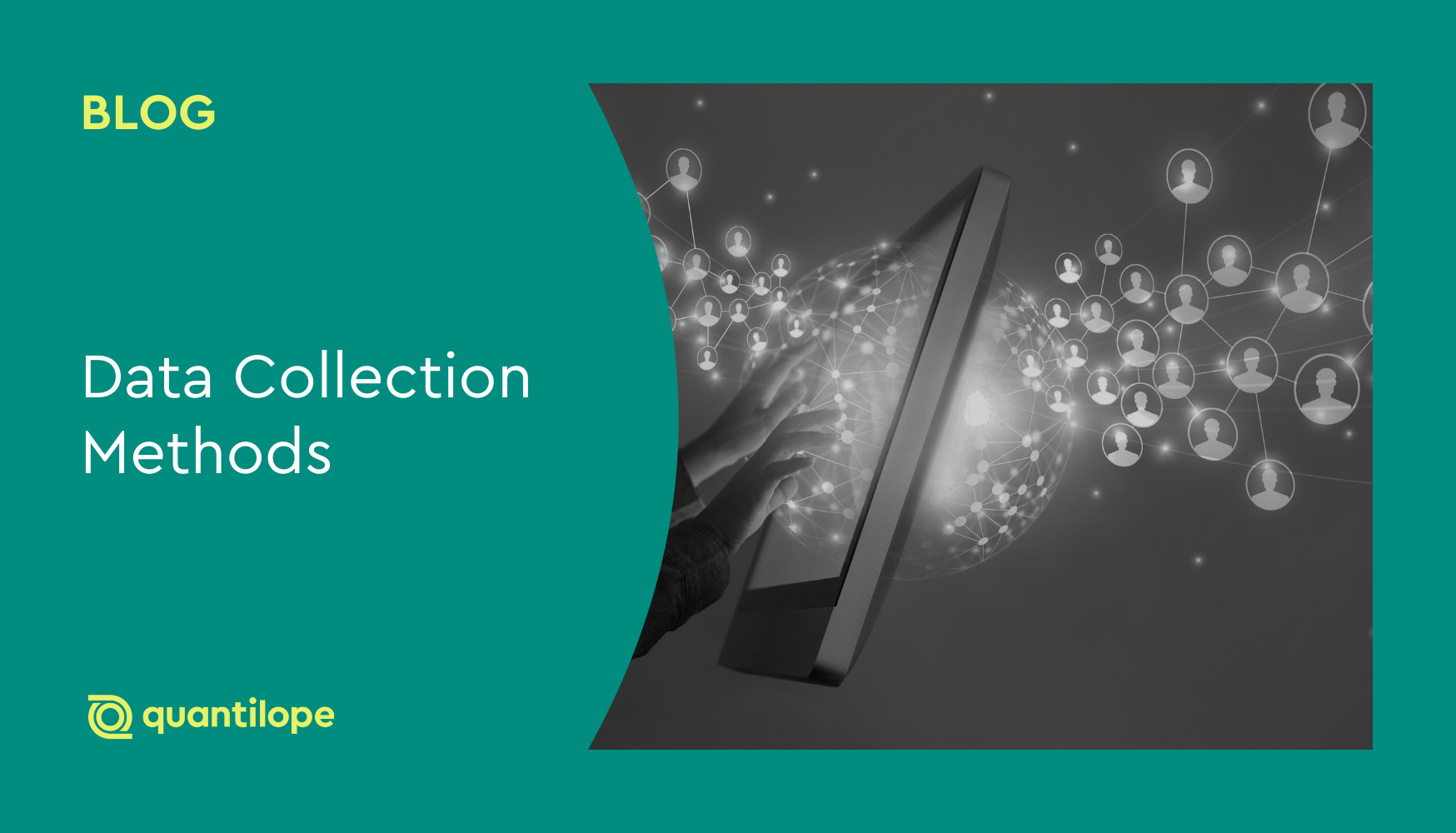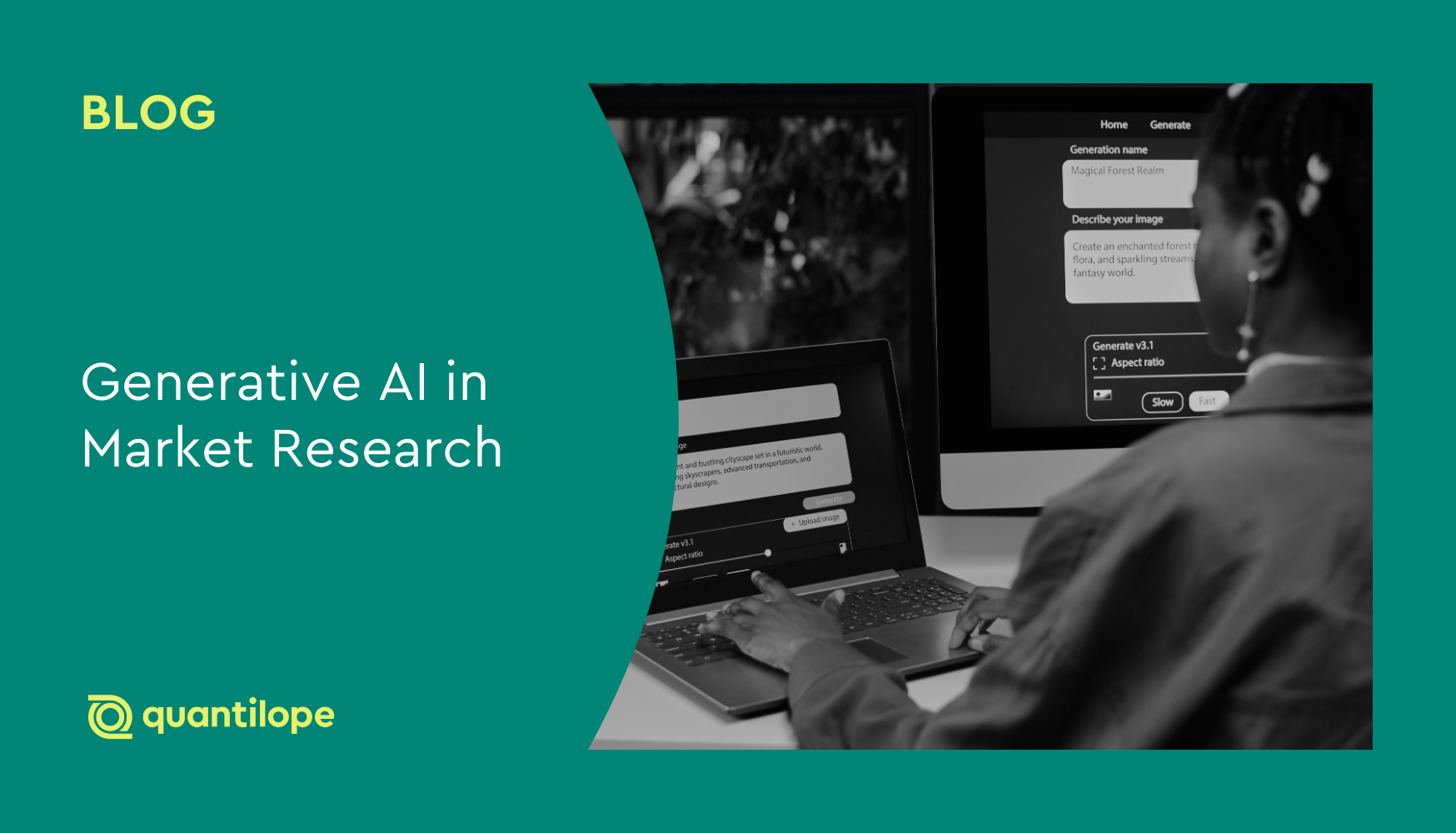In this post, we’ll cover the different options businesses have for collecting data, why it’s crucial to ensure high data quality, and some key challenges to consider.
While it’s important to craft a thoughtful market research study that asks the right questions for your business, it’s just as (if not more) important to ensure high quality insights from your data collection. If you’re making business decisions based on poor-quality data, you’re bound to get poor quality results for your business. Data quality starts with determining the right approach for gathering data alongside using high quality data sample sources such as trusted panel partners.
Table of Contents:
Understanding market research data collection
Before exploring the different types of data collection at researchers’ disposal, let’s start with an overview of what data collection is in market research.
What is data collection in market research?
Data collection in market research is the systematic gathering of responses from a clearly defined target audience, often pertaining to a specific market or industry. The process of gathering responses (aka, data collection) can be done in a number of ways which we’ll explore below, though the end goal remains the same: to make data-driven decisions that fuel business growth. Data collection is used for a variety of objectives, from understanding consumer behavior and consumer preferences to analyzing a brand’s market size or competitive advantage. With an abundance of tools on the market today, from traditional data collection agencies to advanced AI platforms and solutions, valuable insights are at nearly every market researcher’s fingertips.
Why data collection is crucial for strategic decision-making
Effective market research data collection comes down to the processes, tools, and partners a business has in place. With the right resources, data collection serves as a foundation for understanding evolving customer needs and keeping up with emerging market trends to gain a competitive edge. More specifically, data collection allows brands to identify new, untapped opportunities, mitigate potential risks before it’s too late, tailor new product development efforts, refine marketing strategies, and optimize pricing models. Leaving these decisions to gut feel or intuition rather than basing them off of trusted, validated data puts a business at risk of product flops or failed campaigns.
The evolution of data collection in market research
The process of collecting data has changed significantly over the years, mirroring technological advancements and evolving consumer behaviors. Historically, market research data collection was limited to traditional, manual methodologies such as paper-based questionnaires or face-to-face interviews and observations. While face-to-face interviews are still a methodology widely used today for their unique qualitative advantages, the digital age has drastically shifted the way researchers deploy questionnaires. Over time, paper surveys were replaced by online surveys and sent to the masses through email or digital links. The shift to online data collection opened a whole new realm of possibilities, with market researchers able to multiply the amount of data they could collect, and at unprecedented speed.
Today, a whole new era of data collection continues to evolve thanks to automated insights platforms and Artificial Intelligence (AI). Now, researchers not only can capture vast amounts of data in a short period of time, they can monitor and work with that data in real-time and lean on AI tools to help analyze and interpret insights before fieldwork is even complete.
The evolution of data collection is exciting and only continues to develop. Who knows what data collection will look like in 5 or 10 years from now as technology continues to evolve at a rapid pace, offering researchers an ever-expanding toolkit for trusted consumer insights.
Back to Table of Contents
Qualitative vs. quantitative data collection
Market research data collection methods can be broadly categorized into qualitative and quantitative approaches, each serving distinct research objectives.
When to use qualitative research methods
Qualitative research methods are primarily exploratory in nature and useful when a brand’s goal is to gain a deeper understanding of consumers’ underlying opinions, motivations, and attitudes. Qualitative methods are particularly useful when exploring complex issues, generating hypotheses, uncovering unmet needs, and gaining rich, descriptive insights into the “why” of consumer behavior. In the sections below, we’ll highlight some common qualitative methods such as in-person interviews and focus groups.
When to use quantitative research methods
Quantitative research methods, on the other hand, focus on collecting numerical data that brands can statistically analyze to make generalizations about a larger population. Brands use quantitative methods when their research objective is to quantify (hence the name) opinions, attitudes, behaviors, and other variables, and to identify statistically significant relationships. With their collected numerical data, brands can create charts, graphs, and reports to present to key stakeholders.
Combining methods for comprehensive insights
Often, the most comprehensive and insightful market research approaches leverage a combination of both qualitative and quantitative methods, an approach known as mixed-methods research. Researchers can use qualitative research to explore an issue in depth and develop hypotheses, then further test and quantify those hypotheses using quantitative research. Conversely, research teams can start with quantitative research to identify trends that can then be further explored and explained through qualitative methods like focus groups or interviews. This combination of data from different data sources provides a robust and nuanced understanding of the market.
Back to Table of Contents
Primary data collection methods
Primary data collection involves gathering firsthand information, specifically tailored to unique research objectives. This data is original and collected directly from the source. Below are a few examples of what those primary data sources might be.
Surveys and questionnaires
Surveys and questionnaires are widely-used primary data collection methods that involve gathering information directly from respondents through a structured set of questions. These can be administered in various formats – most commonly online surveys platforms, but also via mail, telephone, or in-person. The reason online surveys have become so popular over the years is due to their cost-effective nature, speed of distribution and collection, and the ability to reach a vast amount of consumers regardless of their geographic location. Online surveys also let researchers apply statistical methods, data cleaning tools, and other means of validation to ensure an actionable and high quality data set.
Using an online questionnaire, brands can ask respondents questions using a range of question formats such as multiple-choice, rating scales, and open-ended questions. They can also ‘screen’ respondents so that they fall into certain demographic or psychographic groups that best reflect their target audience. With the collected data, researchers can create helpful chart visualizations and reports to share with stakeholders.
In-person interviews
In-depth interviews are another form of primary data collection, this one being a qualitative research technique compared to the quantitative survey approach. Interviews encompass one-on-one conversations between a moderator and a participant, where the moderator will gain rich, detailed insights into consumers’ perspectives, experiences, beliefs, and motivations related to a particular topic. A research team will curate an interview guide for the moderator (of whom should be unbiased toward the research at hand). Using the interview guide as a starting point, interviews can be as structured or unstructured as needed, allowing the interviewer to probe deeper into responses that arise and explore nuances that can’t be explored through quantitative means alone (like a survey).
Skilled interviewers will use open-ended questions and active listening techniques to encourage respondents to share detailed narratives and perspectives without introducing research bias. In-depth interviews are particularly valuable when seeking to understand complex issues, uncover underlying reasons for behavior, or gain a deep understanding of individual experiences.
Focus groups
Focus groups are another valuable qualitative research method that involves bringing together a small, carefully selected group of participants to engage in a guided discussion about a specific product, service, concept, or marketing campaign. Similar to one-on-one interviews, a trained moderator facilitates the discussion, ensuring that all participants have an opportunity to share their thoughts and perspectives while keeping the conversation focused on the research objectives. The interactive nature of focus groups can elicit a wide range of opinions and insights, often uncovering unexpected perspectives and generating creative ideas through group dynamics. Focus groups are particularly useful for exploring consumer perceptions, testing new product concepts, and understanding group attitudes.
Observational research
Observational research involves systematically watching and recording the behavior of individuals or groups in their natural environment without direct interaction. This primary research method aims to understand actions, interactions, and patterns of behavior as they naturally occur. Observational research can be structured (using predefined categories of behavior to record) or unstructured (allowing for more open-ended observation). Observations can be conducted in-person (e.g., observing shoppers in a retail store) or remotely using technologies like video cameras or online tracking tools (with participants’ opt-in). Observational research provides valuable insights into actual consumer behavior, which may differ from what people say or claim in surveys or interviews.
Online tracking and digital analytics
Given the rise of digital tools, online tracking and digital analytics have become increasingly powerful primary data collection methods. These techniques utilize various tools and technologies to monitor and analyze user behavior on websites, mobile applications, social media platforms, and other digital channels. By tracking metrics such as website visits, page views, click-through rates, time spent on pages, conversion rates, and social media engagement, organizations can gain valuable insights into how users interact with their brand’s online presence and content. Digital analytics platforms provide a wealth of quantitative data on user behavior, trends, and patterns, along with insights into user experiences and the success of marketing efforts.
Back to Table of Contents
Secondary data collection methods
Whereas primary data collection involves new and unique insights, secondary data collection is the use of pre-existing information that has already been collected for another purpose. This type of data can be a cost-effective way to gather initial insights and context for a research project. Below are a few common sources of secondary data for market research.
Industry reports and publications
Industry reports and publications from market research firms, industry associations, and consulting companies provide research teams with valuable pre-existing data on specific markets, industries, and sectors. These reports often provide a broad overview and in-depth understanding of the market such as market size estimates, growth forecasts, and category trends.
Government data sources
Government agencies at local, regional, and national levels collect and publish a vast amount of demographic, economic, and social data. This publicly-available information can be a rich source of secondary data for market researchers. Examples of government data sources include census data, economic indicators, labor statistics, trade figures, and health statistics.
Competitor analysis
Competitor analysis involves gathering and analyzing publicly-available information about competitors' strategies, products, pricing models, marketing campaigns, distribution channels, and customer reviews. Research teams can gather this kind of competitor information from company websites, annual reports, public marketing materials, press releases, social media activity, and even online customer reviews. This type of secondary data can provide valuable insights into a competitive landscape, identify competitor strengths and weaknesses, and inform strategic positioning.
Social media monitoring
With the explosion of social media over the years, social platforms are a rich secondary source of insights. Social media monitoring involves tracking and analyzing social conversations, mentions, and trends related to a brand, industry, or specific topic – across various social media platforms. By utilizing social listening tools, researchers gain insights into public opinion, brand sentiment, customer feedback, emerging trends, and competitor activities in real-time, from consumers’ own voices. This mix of qualitative data (consumer conversations) and quantitative data (social media metrics) help brands understand consumer preferences and market trends as they’re happening.
Back to Table of Contents
Key challenges in market research data collection
Despite the advancements in data collection techniques, market researchers can still face some challenges. Below are a few areas to consider when collecting or sourcing data for your study.
Ensuring data quality and validity
Within the world of market research, there’s always the question of data quality and the validity of research findings. While using trusted panel partners can help mitigate these concerns, there are also steps researchers can take on their own to improve the accuracy and reliability of their collected data.
Data quality starts with your questionnaire itself by making sure your survey questions are unbiased, you account for respondent fatigue in the length of your survey, and you check the survey logic before fully sending out to respondents (many refer to this as a ‘soft launch’). Once you’ve collected your data (or even while still in field), check your responses and clean out those who don’t meet your quality standards. Many research platforms (like quantilope) have automated these types of data cleaning filters to make it even easier to ensure valid, high quality data.
Overcoming response bias
Response bias occurs when respondents' answers are systematically different from the true population values due to factors such as leading questions, social desirability bias (the tendency to answer in a way that is seen as socially acceptable), acquiescence bias ( where individuals are likely to agree with something regardless of how they actually feel), or non-response bias (differences between those who participate in the research and those who do not).
To reduce the risk of bias in your survey results, make sure to test your survey among a smaller population before officially launching it (i.e. soft launch) and have multiple team members review the survey internally to get multiple perspectives on question wording. Response bias is also why using a reputable panel provider for your survey sample is so important, as they can source participants that meet your desired target population criteria.
Maintaining GDPR and privacy compliance
In today’s digital-centric world, market research regulations like the General Data Protection Regulation (GDPR) have been put in place to ensure the privacy and security of participant data. To ensure privacy compliance for your study, make sure to obtain clear consent for data collection, anonymize data wherever possible (like name, date of birth, location, etc.), and establish secure data storage systems. Failure to comply with GDPR and other privacy regulations can lead to significant fines and reputational damage, making it paramount to consider privacy at every stage of your data collection process.
Addressing timing and budget constraints
Market research projects often operate under tight timeframes and budget limitations. This is in part because researchers today are tasked with gathering more insights in quicker timeframes (something known as the ‘Research Dilemma’). Because of this, researchers are constantly seeking efficient and cost-effective methods for gathering valuable insights. Traditional data collection approaches (through research agency panel bidding) can be time-consuming and resource-intensive, involving lengthy fieldwork and turnaround times, manual data cleaning, and complex data analysis. Modern methodologies and technological advancements offer solutions to mitigate these challenges.
Automated, online survey platforms and agile research techniques can significantly reduce the time required for data collection and analysis, with many offering the option to connect panel directly within the platform and monitor data in real time. These innovative digital data collection tools can help optimize research budgets without compromising data quality.
Back to Table of Contents
Modern approaches to market research data collection
Market research is continuously evolving, with new technologies and methodologies constantly emerging to provide richer, quicker, and more accurate insights. Modern-day approaches to data collection leverage digital platforms, mobile devices, and the power of the web to reach vast audiences and gather diverse forms of data. Online surveys, social media listening, mobile ethnography, and in-app feedback mechanisms are just a few examples of how researchers are moving beyond traditional methods of data collection with lengthy timeframes spanning multiple agency teams. Today’s digital survey approaches offer greater flexibility, scalability, and real-time access to data, enabling research teams to run more research projects, faster (thus solving the above-mentioned ‘Research Dilemma’).
Additionally, artificial intelligence (AI) and machine learning further streamline the data collection process through automated data cleaning procedures and quality checks (as opposed to the tedious, manual processes expected with traditional research agencies).
Back to Table of Contents
Selecting the right data collection method for your organization
Choosing the most appropriate data collection method is a critical decision that depends on research objectives, target audience, budget, timeline, and the nature of the information being sought (i.e. verbal feedback from potential customers or numerical charts that quantify marketing efforts). There’s no one-size-fits-all solution, and researchers should carefully consider the strengths and limitations of different approaches. For example, a startup or small business with limited budget or resources would benefit from a combination of cost-effective secondary research and targeted primary research.
As a summary to the sections above, quantitative methods such as surveys and questionnaires are well-suited for measuring attitudes, behaviors, and opinions across a large sample. Meanwhile, qualitative methods such as focus groups and in-person interviews provide deeper insights into motivations, perceptions, and experiences. Increasingly, organizations are adopting hybrid approaches that combine both quantitative and qualitative techniques to gain a more comprehensive understanding of their research questions. Take quantilope's platform for example, where many clients opt to run quantitative studies and supplement those insights with quantilope’s qualitative video solution, inColor, for richer, more detailed feedback.
When choosing your data collection method(s), always consider ethical implications and the potential impact on participant privacy.
Back to Table of Contents
Data collection with quantilope
quantilope makes data collection simple by offering panel agnostic capabilities, directly integrated into its platform. That means research teams can connect to any panel of their choice and set their survey live with just a few clickable settings. For those that want to use third-party sample (as opposed to their own source), quantilope’s panel consulting team will work with a trusted set of panel providers to find the right fit for your particular study. quantilope’s commitment to data privacy and security ensures full compliance with regulations like GDPR, providing researchers with peace of mind.
Once you connect your panel source, you can monitor field results in real-time and apply data cleaning filters with the click of a button. quantilope’s automated data cleaning filters catch ‘speeders’ (those who complete the survey faster than average), ‘straight-liners’ (those who answer the same way for a certain number of scale or multiple choice questions), and those who provide poor quality open-end responses. quantilope's Pre-Survey Defense module even goes a step further to screen participants before they enter your survey. In addition to quantilope's data cleaning flags and filters, research teams can always set up their own manual data cleaning flags to clean out any niche criteria they don’t want in their final results.
To learn more about data collection with quantilope's Consumer Intelligence Platform, get in touch below!




.png)
